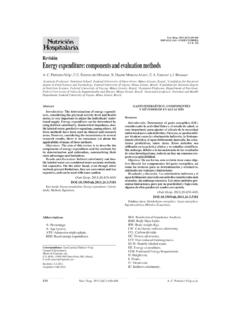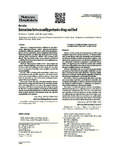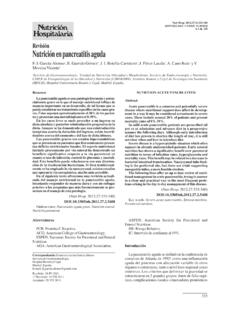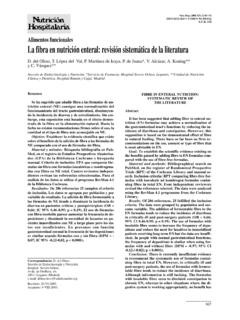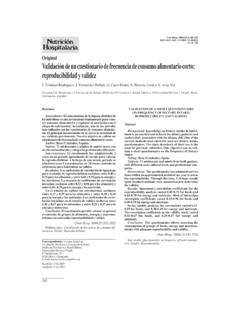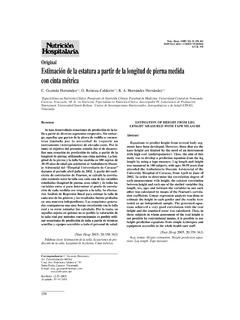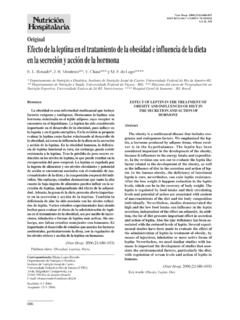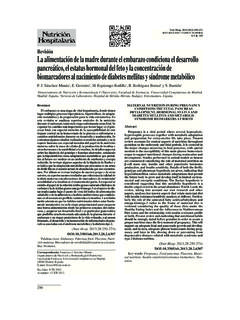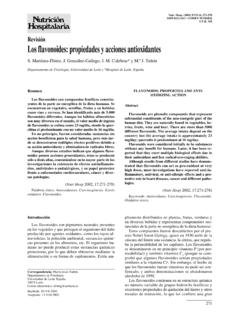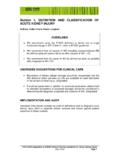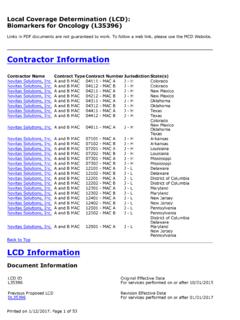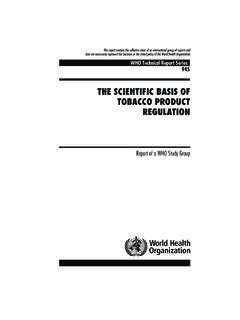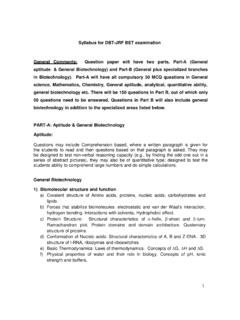Transcription of Biomarkers: background, classification and guidelines for ...
1 Nutr Hosp. 2015;31(Supl. 3):177-188. ISSN 0212-1611 CODEN NUHOEQ. 318. biomarkers : background , classification and guidelines for applications in nutritional epidemiology Dolores Corella1,2 and Jos M. Ordov s3,4,5. 1. Unidad de Epidemiolog a Gen tica y Molecular. Departamento de Medicina Preventiva y Salud P blica, Ciencias de la Alimentaci n, Toxicolog a y Medicina Legal. Universidad de Valencia. 2 CIBER Fisiopatolog a de la Obesidad y Nutrici n. Instituto de Salud Carlos III, Madrid. 3 Department of Cardiovascular Epidemiology and Population Genetics, Centro Nacional de Investigaciones Cardiovasculares (CNIC), Madrid. 4 IMDEA Alimentaci n, Madrid. Spain. 5 Nutrition and Genomics Laboratory, JM-USDA Human Nutrition Research Center on Aging at Tufts University, Boston, MA. USA. Abstract BIOMARCADORES: ANTECEDENTES, CLASIFICACI N Y GU A PARA SU.
2 One of the main problems in nutritional epidemiology APLICACI N EN EPIDEMIOLOG A. is to assess food intake as well as nutrient/food compo- NUTRICIONAL. nent intake to a high level of validity and reliability. To help in this process, the need to have good biomarkers that more objectively allow us to evaluate the diet con- Resumen sumed in a more standardized, valid and precise way En los estudios de epidemiolog a nutricional uno de los has often been commented upon. There are various de- principales problemas es conocer la ingesti n de alimen- finitions of biomarkers and also different classifications tos y sus componentes de manera v lida y precisa. Para of the same. In general a biomarker can be defined as a ayudar en este proceso se ha planteado repetidas veces la characteristic that can objectively measure different bio- necesidad de contar con buenos biomarcadores, que de logical samples and that can be evaluated as an exposu- manera m s objetiva nos permitan conocer de manera re marker of normal or pathogenic biological processes m s estandarizada, v lida y precisa la dieta consumida.
3 Or of responses to a certain intervention. The biological Existen varias definiciones de biomarcador y tambi n samples most commonly used in nutritional epidemiolo- distintas clasificaciones de los mismos. En general un gy are blood, red blood cells, plasma, serum, urine, nails, biomarcador es una caracter stica que puede medir ob- saliva, faeces and samples of different tissues. Exposure jetivamente en distintas muestras biol gicas y que pue- biomarkers (dietary intake), biomarkers of effects and de evaluarse como indicador de exposiciones, de proce- biomarkers of disease status can be determined from sos biol gicos normales o patog nicos o de respuestas a these samples. In turn, exposure biomarkers can be tem- una intervenci n determinada. Las muestras biol gicas porarily categorized into markers of acute, medium term m s utilizadas en epidemiolog a nutricional son sangre or chronic effects.
4 Many difficulties arise in identifying total, eritrocitos, plasma, suero, orina, u as, saliva, he- good biomarkers . Currently, advances in omics are ope- ces y muestras de distintos tejidos. En estas muestras se ning up new possibilities for obtaining new biomarkers of pueden determinar biomarcadores de exposici n (inges- various kinds, using genomics, epigenomics, transcripto- ta diet tica), biomarcadores de efectos y biomarcadores mics, lipidomics, proteomics and metabolomics. We shall de estado de enfermedad. A su vez los biomarcadores de review the present situation of biomarkers in nutritional exposici n pueden categorizarse temporalmente en bio- epidemiology as well as the future trends of the new omic marcadores de efectos agudos, a medio plazo y cr nicos. biomarkers . Existen muchas dificultades en la identificaci n de bue- (Nutr Hosp 2015;31(Supl.))
5 3):177-188) nos biomarcadores. Actualmente los avances en las nue- vas micas est n abriendo nuevas posbilidades para la obtenci n de nuevos biomarcadores de distintos tipos uti- Key words: Biomarker. Diet. Intake. Biological sample. lizando gen mica, epigen mica, transcript mica, lipid - Genomics. Transcriptomics. Metabolomics. mica, prote mica y metabol mica. Revisaremos el estado actual de los biomarcadores en epidemiolog a nutricional as como las tendencias futuras de los nuevos biomarca- dores micos. (Nutr Hosp 2015;31(Supl. 3):177-188). Palabras clave: Biomarcador. Dieta. Ingesta. Muestra Correspondence: Dolores Corella. biol gica. Gen mica. Transcript mica. Metabol mica. Departamento de Medicina Preventiva y Salud P blica. Facultad de Medicina. Avda. Blasco Ib ez, 15. 46010-Valencia. E-mail: 177. 020_Biomarcadores del consumo alimentario_Dolores 177 12/02/15 14:12.
6 background nizing our understanding of the role of nutrients and food components in health and disease. Although there The limitations of questionnaires are widely recog- is huge interest in the use and development of new bio- nised when it comes to measuring dietary intake with markers, the present situation is that we still do not have sufficient validity and accuracy. Although efforts are good biomarkers for most of the previously mentioned made to improve the validity of those tools by using important aspects. This is so much so that various pu- dietary records or various 24-h recalls instead of the blic and private research organizations are stressing less accurate food frequency questionnaires, random the need to delve deeper into the investigation of new and systematic bias, which make self-reported dietary nutritional biomarkers and are providing an impetus to measurements diverge from the reality, always exists1.
7 Research along these lines. Thus, since one of the initial Moreover, these errors in measuring food intake ex- conclusions of the European Commission-funded pro- tend to nutrients and other food components derived ject PASSCLAIM, coordinated by ILSI Europe, was from the food consumed, not only because the intake that there is a need for adequate markers in nutrition has not been noted down with sufficient validity and sciences, research into better biomarkers (among them accuracy, but because there are other factors such as the recent initiatives of the Joint Programming Initia- variability in the composition of the food consumed, tive (JPI) on food and nutrition in Europe, which this etc. which also contributes to nutrients and food com- year began financing two new projects (MIRDIET and ponents derived theoretically from food composition FOODBALL), has been considered a priority.)
8 These tables not being faithfully adjusted to the real con- projects aim at the validation of biomarkers and the in- sumption. Measuring these intakes well is very impor- vestigation of intake/exposure and nutritional status of tant because, on most occasions, nutritional studies not biomarkers in the area of nutrition and health, the for- only have the aim of getting to know the dietary intake mer being focused on microRNAs and the latter on the of a certain population, but also a second step which application of metabolomics. The United States is now is to study the associations between food intake and a promoting projects aimed at research into nutritional certain health problem. It is, therefore, clearly true that biomarkers and in April, 2012, the Sackler Institute the accurate assessment of dietary exposure is crucial for Nutrition Science and the New York Academy of in investigating associations between diet and disease.
9 Sciences organized a conference entitled biomarkers Hence, other alternative means are required for getting in Nutrition: New Frontiers in Research and Applica- to know the food and nutrient intake (and non-nutritive tion. The aim of this conference was to get scientists food components) contributed by the same with grea- and practitioners from industry, academia, and gover- ter validity and accuracy than that obtained through nment organizations to work together on assessing the self-reported measures. current state of knowledge about nutritional biomar- Nutritional biomarkers are important for future re- kers, to identify important challenges and unanswered search into associations between diet and health, as questions, and to catalyze new research in the field so they can provide an objective assessment method for that soon it may be possible to implement good bio- dietary exposure.
10 However, the definition of biomar- markers in nutritional epidemiology that will enable ker is not simple and there are indeed many definitions a better measuring of food intake, its effects, and its depending on the application of those biomarkers . A association with states of health-disease. widely used definition of biomarker was provided by In this article, we shall review present knowledge the Biomarker Definition Working Group (BDWG)2 in on biomarkers in nutritional epidemiology and will 2001. According to this, a biomarker is a characteris- go deeper into the new omics as these are poised to tic that is objectively measured and evaluated as an revolutionize the identification of new markers in nu- indicator of normal biological processes, pathogenic tritional studies. processes or pharmacologic responses to a therapeutic intervention.
